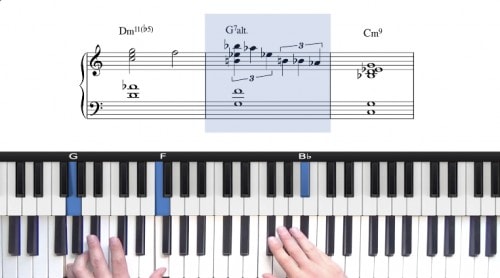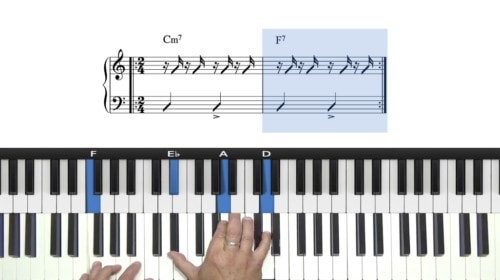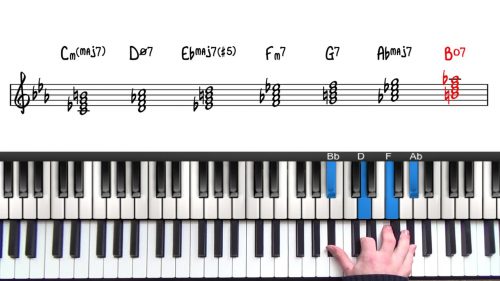Minor Grooves: 251 & 2516 Progressions
In this lesson we create a Bossa Nova Samba groove that we can play over minor harmony. We explore the 251 progression and the 2516 progression in the key of G Minor.
Start With 3 Note Voicings
We start with simple 3-note voicings to establish the basic rhythm and groove between our left and right hands.
We then introduce the b5 on the ii-7 chord to give the progression a distinctly minor quality. When we hold the b5 over to the V7 chord, it becomes the b9 which adds more colour and character to the progression.
Exploring Triad Options
We can view the A-7b5 chord as a C Minor Triad built over the A root note. For the D7b9, we can view this as a diminished 7th chord built from the major 3rd.
Looking at our voicings in this way makes it easier to manoeuvre and invert the voicing shapes around the keyboard and it gives us interesting interval shapes for melodic development.
Adding Extensions & Alterations
We can extend and alter the basic chords to get more interesting colours and flavours over the progression. Adding the 9th and the 11th to the ii-7b5 chord creates a richer and more complex harmonic progression. These notes can also be included in our melodic lines and ideas.
The 2516 Progression
Just as we did in the major grooves lesson, we can add the VI7 chord to create a circular progression. In minor harmony, the VI7 is most often played as an altered dominant voicing.
Lesson Downloads
-
Minor Grooves Lesson Notation File Type: pdf
Practice Tips
-
Start with the simple 3 note voicings and gradually layer in more interesting chord colours and tensions.
-
Understand the role of the VI7alt chord in the minor 2516 progression and how this creates a 'circular' chord progression.
-
Experiment with 'dry' syncopation, and 'wet' syncopation as demonstrated by Jovino.
-
Apply the chord substitutions and reharmonisation outlined by Jovino.








Love the lesson! around 5:39 and a bit onwards – where you were playing some descending notes – really nice effect!! , wish this can be given more explanation as to what notes they were ;) or why those options were played – Thanks very much again. Wish there was a transcription of this piece!